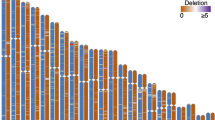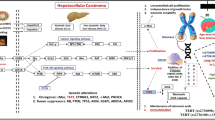Abstract
To identify susceptibility variants for hepatitis B virus (HBV)-related hepatocellular carcinoma (HCC), we conducted a genome-wide association study by genotyping 440,794 SNPs in 355 chronic HBV carriers with HCC and 360 chronic HBV carriers without HCC, all of Chinese ancestry. We identified one intronic SNP (rs17401966) in KIF1B on chromosome 1p36.22 that was highly associated with HBV-related HCC and confirmed this association in five additional independent samples, consisting of 1,962 individuals with HCC, 1,430 control subjects and 159 family trios. Across the six studies, the association with rs17401966 was highly statistically significant (joint odds ratio = 0.61, P = 1.7 × 10−18). In addition to KIF1B, the association region tagged two other plausible causative genes, UBE4B and PGD. Our findings provide evidence that the 1p36.22 locus confers susceptibility to HBV-related HCC, and suggest that KIF1B-, UBE4B- or PGD-related pathways might be involved in the pathogenesis of this malignancy.
This is a preview of subscription content, access via your institution
Access options
Subscribe to this journal
Receive 12 print issues and online access
$209.00 per year
only $17.42 per issue
Buy this article
- Purchase on Springer Link
- Instant access to full article PDF
Prices may be subject to local taxes which are calculated during checkout

Similar content being viewed by others
References
Bosch, F.X., Ribes, J., Cleries, R. & Diaz, M. Epidemiology of hepatocellular carcinoma. Clin. Liver Dis. 9, 191–211 (2005).
Chen, C.J., Yu, M.W. & Liaw, Y.F. Epidemiological characteristics and risk factors of hepatocellular carcinoma. J. Gastroenterol. Hepatol. 12, S294–S308 (1997).
McGlynn, K.A. & London, W.T. Epidemiology and natural history of hepatocellular carcinoma. Best Pract. Res. Clin. Gastroenterol. 19, 3–23 (2005).
Yu, M.W. et al. Prospective study of hepatocellular carcinoma and liver cirrhosis in asymptomatic chronic hepatitis B virus carriers. Am. J. Epidemiol. 145, 1039–1047 (1997).
Chen, C.J. & Chen, D.S. Interaction of hepatitis B virus, chemical carcinogen, and genetic susceptibility: multistage hepatocarcinogenesis with multifactorial etiology. Hepatology 36, 1046–1049 (2002).
Kim, Y.J. & Lee, H.S. Single nucleotide polymorphisms associated with hepatocellular carcinoma in patients with chronic hepatitis B virus infection. Intervirology 48, 10–15 (2005).
Zhai, Y. et al. Estrogen receptor alpha polymorphisms associated with susceptibility to hepatocellular carcinoma in hepatitis B virus carriers. Gastroenterology 130, 2001–2009 (2006).
Aulchenko, Y.S. et al. Genetic variation in the KIF1B locus influences susceptibility to multiple sclerosis. Nat. Genet. 40, 1402–1403 (2008).
Stacey, S.N. et al. Common variants on 1p36 and 1q42 are associated with cutaneous basal cell carcinoma but not with melanoma or pigmentation traits. Nat. Genet. 40, 1313–1318 (2008).
Bagchi, A. & Mills, A.A. The quest for the 1p36 tumor suppressor. Cancer Res. 68, 2551–2556 (2008).
Li, S.P. et al. Genome-wide analyses on loss of heterozygosity in hepatocellular carcinoma in Southern China. J. Hepatol. 34, 840–849 (2001).
Midorikawa, Y. et al. Allelic imbalances and homozygous deletion on 8p23.2 for stepwise progression of hepatocarcinogenesis. Hepatology 49, 513–522 (2009).
Nangaku, M. et al. KIF1B, a novel microtubule plus end-directed monomeric motor protein for transport of mitochondria. Cell 79, 1209–1220 (1994).
Yeh, I.T. et al. A germline mutation of the KIF1B βgene on 1p36 in a family with neural and nonneural tumors. Hum. Genet. 124, 279–285 (2008).
Yang, H.W. et al. Genomic structure and mutational analysis of the human KIF1B gene which is homozygously deleted in neuroblastoma at chromosome 1p36.2. Oncogene 20, 5075–5083 (2001).
Benn, D.E. et al. Sporadic and familial pheochromocytomas are associated with loss of at least two discrete intervals on chromosome 1p. Cancer Res. 60, 7048–7051 (2000).
Schlisio, S. et al. The kinesin KIF1Bβ acts downstream from EglN3 to induce apoptosis and is a potential 1p36 tumor suppressor. Genes Dev. 22, 884–893 (2008).
Munirajan, A.K. et al. KIF1Bβ functions as a haploinsufficient tumor suppressor gene mapped to chromosome 1p36.2 by inducing apoptotic cell death. J. Biol. Chem. 283, 24426–24434 (2008).
Hoeller, D., Hecker, C.M. & Dikic, I. Ubiquitin and ubiquitin-like proteins in cancer pathogenesis. Nat. Rev. Cancer 6, 776–788 (2006).
Dawson, S.P. Hepatocellular carcinoma and the ubiquitin-proteasome system. Biochim. Biophys. Acta 1782, 775–784 (2008).
Koegl, M. et al. A novel ubiquitination factor, E4, is involved in multiubiquitin chain assembly. Cell 96, 635–644 (1999).
Krona, C. et al. Screening for gene mutations in a 500 kb neuroblastoma tumor suppressor candidate region in chromosome 1p; mutation and stage-specific expression in UBE4B/UFD2. Oncogene 22, 2343–2351 (2003).
Chatterjee, A. et al. U-box-type ubiquitin E4 ligase, UFD2a attenuates cisplatin mediated degradation of Np63α. Cell Cycle 7, 1231–1237 (2008).
Novello, F. & McLean, P. The pentose phosphate pathway of glucose metabolism. Measurement of the non-oxidative reactions of the cycle. Biochem. J. 107, 775–791 (1968).
Turyn, J. et al. Increased activity of glycerol 3-phosphate dehydrogenase and other lipogenic enzymes in human bladder cancer. Horm. Metab. Res. 35, 565–569 (2003).
Giusti, L. et al. Fine-needle aspiration of thyroid nodules: proteomic analysis to identify cancer biomarkers. J. Proteome Res. 7, 4079–4088 (2008).
Genome-wide association study of 14,000 cases of seven common diseases and 3,000 shared controls. Nature 447, 661–678 (2007).
Kazeem, G.R. & Farrall, M. Integrating case-control and TDT studies. Ann. Hum. Genet. 69, 329–335 (2005).
Nicodemus, K.K. Catmap: case-control and TDT meta-analysis package. BMC Bioinformatics 9, 130 (2008).
Browning, B.L. & Browning, S.R. A unified approach to genotype imputation and haplotype-phase inference for large data sets of trios and unrelated individuals. Am. J. Hum. Genet. 84, 210–223 (2009).
Sole, X., Guino, E., Valls, J., Iniesta, R. & Moreno, V. SNPStats: a web tool for the analysis of association studies. Bioinformatics 22, 1928–1929 (2006).
Menashe, I., Rosenberg, P.S. & Chen, B.E. PGA: power calculator for case-control genetic association analyses. BMC Genet. 9, 36 (2008).
Yu, M.W. et al. Familial risk of hepatocellular carcinoma among chronic hepatitis B carriers and their relatives. J. Natl. Cancer Inst. 92, 1159–1164 (2000).
Houlston, R.S. & Ford, D. Genetics of coeliac disease. QJM 89, 737–743 (1996).
Acknowledgements
We thank the subjects and their families for participating in this study, and the clinicians, nurses and study coordinators for their contributions. This study was supported in part by grants from Chinese National High-tech Program 2006AA02A412 (G.Z.), Chinese Key Project for Infectious Diseases 2008ZX10002-016 (G.Z.), Chinese National Science Fund for Creative Research Groups Program 30621063 (F.H.) and Beijing Science and Technology NOVA program 2006A54 (G.Z.).
Author information
Authors and Affiliations
Contributions
G.Z. and F.H. were the overall GWAS study principal investigators who conceived the study and obtained financial support. F.H., G.Z. and H.Z. designed the study. Y.C., W.X., R.L., Z.W., F.M. and W.H. were responsible for recruitment of Guangxi subjects, phenotype collection and biological sample collection and preparation. W.J., Y.Y., M.C. and Y.-X.Z. were responsible for recruitment of Guangdong subjects, phenotype collection and biological sample collection and preparation. Z.H., H.S. and X.Y. were responsible for recruitment of Jiangsu subjects, phenotype collection and biological sample collection and preparation. J.Y. and J.Q. were responsible for recruitment of Shanghai subjects, phenotype collection and biological sample collection and preparation. C.W. and D.L. were responsible for recruitment of Beijing subjects, phenotype collection and biological sample collection and preparation. Y.Z., L.Y., P.L., Z.W., F.M., W.H., W.Y., M.C., X.Z., W.Q., H.Y. and H.Z. performed genotyping in the replication stage. X.X. helped to manage genotype data. F.G., Y.Z. and F.M. conducted functional experiments. G.Z. and H.Z. conducted sample selection and data management, performed statistical analyses, interpreted results and wrote the manuscript.
Corresponding authors
Ethics declarations
Competing interests
The authors declare no competing financial interests.
Supplementary information
Supplementary Text and Figures
Supplementary Tables 1–15, Supplementary Figures 1–10 and Supplementary Note (PDF 1672 kb)
Rights and permissions
About this article
Cite this article
Zhang, H., Zhai, Y., Hu, Z. et al. Genome-wide association study identifies 1p36.22 as a new susceptibility locus for hepatocellular carcinoma in chronic hepatitis B virus carriers. Nat Genet 42, 755–758 (2010). https://doi.org/10.1038/ng.638
Received:
Accepted:
Published:
Issue Date:
DOI: https://doi.org/10.1038/ng.638
This article is cited by
-
The role of kinesin family members in hepatobiliary carcinomas: from bench to bedside
Biomarker Research (2024)
-
Genome-wide functional integration identified MAZ-controlled RPS14 dysregulation in hepatocellular carcinoma
Archives of Toxicology (2024)
-
Outer dynein arm docking complex subunit 2 polymorphism rs7893462 modulates hepatocellular carcinoma susceptibility and can serve as an overall survival biomarker for hepatitis B virus-related hepatocellular carcinoma after hepatectomy: a cohort study with a long-term follow-up
World Journal of Surgical Oncology (2023)
-
A novel tumor suppressor encoded by a 1p36.3 lncRNA functions as a phosphoinositide-binding protein repressing AKT phosphorylation/activation and promoting autophagy
Cell Death & Differentiation (2023)
-
An enhancer variant at 16q22.1 predisposes to hepatocellular carcinoma via regulating PRMT7 expression
Nature Communications (2022)



